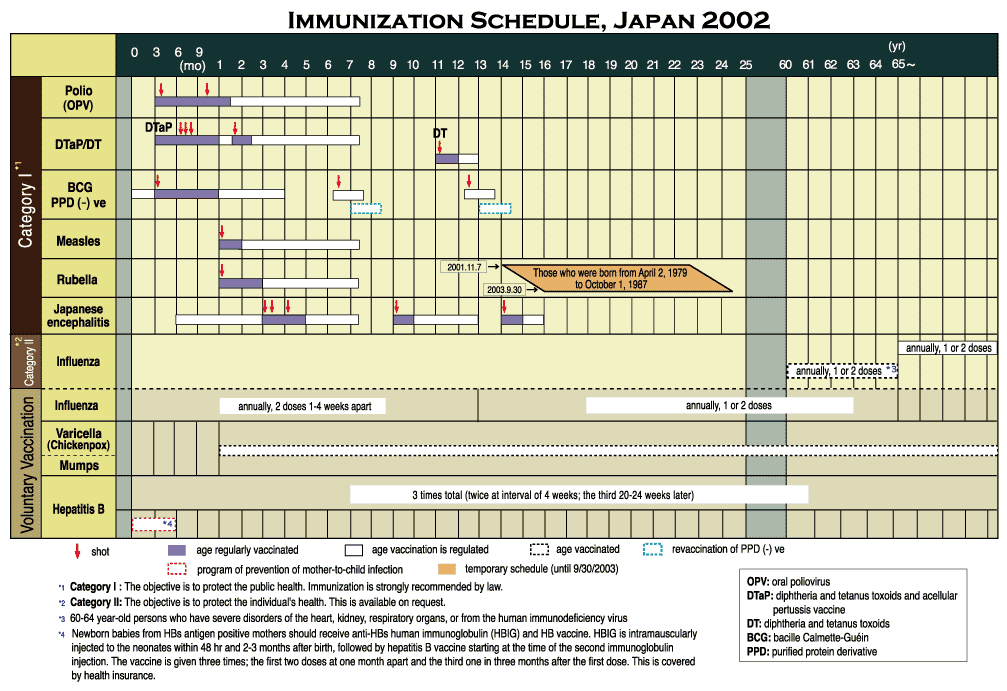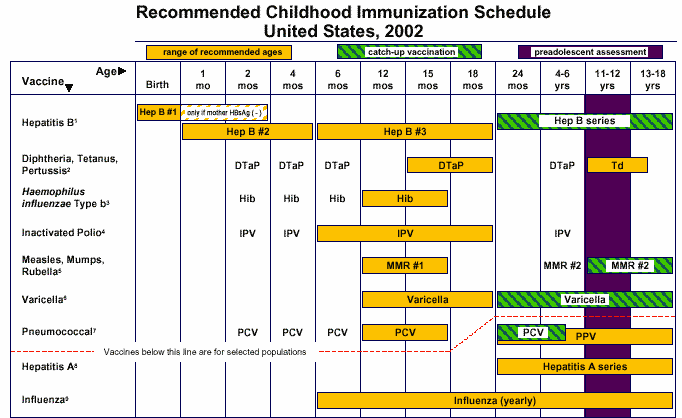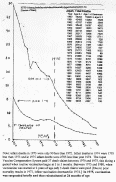Two 'immunization schedules' follow, the 1st is from Japan and the second is from the USA (CDC). One can readily compare the current recommendations for the two countries.
You will note that Japan recommends, in the first year of life:
six injections. (Count the
red arrows, each of which is a shot.) And only
three more in the second year of life.
Now count the shots recommended in the CDC recommended schedule, 13 in the first 12 months, with 15 being possible because an infant may receive the third Hep B and the third IPV shot in the first year of life. And seven more in the second year of life.
This does not take into account that the infant might be in a selected population in either country and be recommended for yet one more shot in the first year of life. The total for most children is 20 injections in the first two years of life in the USA and only 9 injections in the first two years in Japan.


Source of Japan immunization .GIF file:
http://idsc.nih.go.jp/yosoku99/image-E/Imm_en.gif image of immunization schedule Japan.
Source of .PDF file with the same information:
Immunization Schedule 2002, Japan - Download of PDF (35K)
found at:http://idsc.nih.go.jp/yosoku99/index-E.html National Institute of Infectious Diseases (NIID)
For a discussion group, with members on various sides of the immunization question in Japan, see the following: http://www.tokyowithkids.com/discussions/messages/35/38.html
Tokyo With Kids - Forums: Health Topics: Immunizations
The following quote is from the above link:
"By Cornelia on Wednesday, June 21, 2000 - 10:10 am:Here is a list of the government provided vaccinations in Tokyo, Japan (free), all finished before four years old. I don't know what happens after the child enters first grade, but I know that many health initiatives are implemented through the school system. So if a child does not go to a Japanese school he/she may not receive the same services that a typical Japanese child would.
Tuberculin skin test : about 4-5 months after birth Tuberculosis immunization (BCG) : a couple of days later (4-5 months after birth).
This one looks really odd, twice the childs arm is punctured with a very fine array of 9 prongs and the immunization is rubbed in. Then after a day you can't hardly see anything happened but about a week later all 18 punctures become quite noticeable again. It takes 1 to 1.5 years for these marks to recede. ..."
In Japanese, the official immunization schedule according
to the Immunization Law which was ammended on April 1, 1995.
http://www.y-min.or.jp/vaccine/houritu.html
Background on the controversy regarding
raising the minimum age of vaccination.
http://www.whale.to/vaccines/scheibner1.html
Comments on JAPANESE SIDS REBUTTAL[Japan and Britian both proved that less vaccination of infants results in lower overall mortality figures in that age group.]
Transcript of TV Broadcast: MMR problems in Japan

Click for larger graph of infant mortality in Japan 1960-1990
Use Browser 'back' to return here
[Data source for above graph:
http://www.demog.berkeley.edu/wilmoth/mortality/japan/deaths/cod_Dx.5x1]
Why Japan stopped using MMR
Friday, 8 February, 2002, 06:49 GMT
By the BBC's Charles Scanlon in Tokyo http://news.bbc.co.uk/hi/english/world/asia-pacific/newsid_1808000/1808316.stm
Some SIDS references
An article in Japanese on SIDS which I could not read, contained some references in English which may be of use to students.
2.Sawaguchi T, Nelson EAS, Fujita T, Sawaguchi A, Knight B.
Is the incidence of SIDS increasing in Asia? Int J Legal Med
111: 278-280, 1998.
3.Sawaguchi T, Fujita T, Kobayashi M, Sawaguchi A.
Underdiagnosis of Sudden Infant Death Syndrome in Japan.
Acta Criminologiae et Medicinae Legalis Japonica 63(1):
10-22, 1997.
4.Sawaguchi T, Fujita T, Knight B, Sawaguchi A. Statistical
relationship between sudden infant death syndrome and
congenital anomaly in Wales. Acta Criminologiae et
Medicinae Legalis Japonica 63(5-6): 158-163, 1997.
8.Sawaguchi T, Fujita T, Sawaguchi A. Characterization of gray
zone sudden infant death syndrome (SIDS) in Japan using
survey sheets for death: Vital statistics from the Ministry of
Health and Welfare. Rom J Leg Med 4(2):11-117, 1996.
9.Sawaguchi T, Sawaguchi A, Fujita T, Knight B. Still-birth and
SIDS: A report of a statistically significant relationship. Journal
of Sudden Infant Death Syndrome and Infant Mortality 1(2):
109-111, 1996.
10.Sawaguchi T, Fujita T. Kobayashi M, Sawaguchi A.
Characterisation of classical Sudden Infant Death Syndrome
(SIDS) and gray zone SIDS in Japan using Japanese
pathology and autopsy report(1982-1986) from the Japanese
Society of Pathology. ADLI TIP BULTENI 1:58-63, 1996.
11.Sawaguchi T, Fujita T, Sawaguchi A. The trend of the
overdiagnosis and underdiagnosis of sudden infant death
syndrome in Japan. Journal of Sudden Infant Death Syndrome
and Infant Mortality 1(4):307-313, 1996.
12.Fujita T, Kato K. Risk factors for SIDS in Japan: A
record-linkage study based on vital statistics. Acta Paediatrica
Japonica 36: 325-328, 1994.